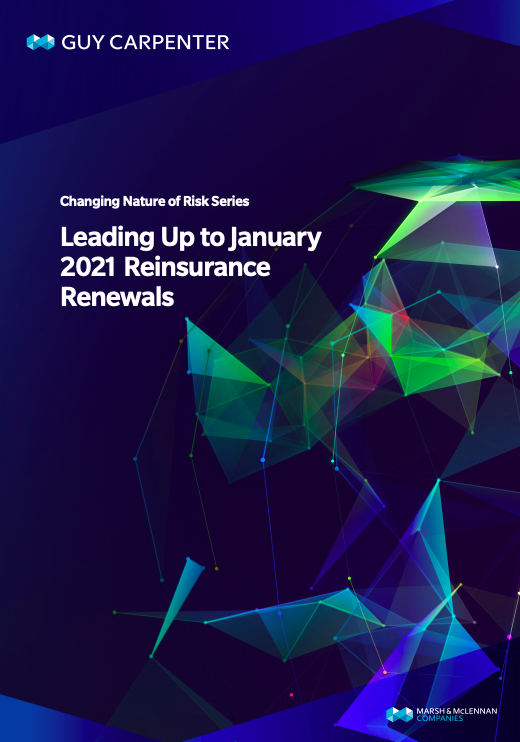

Changing Nature of Risk Series: Leading Up to January 2021 Reinsurance Renewals
Guy Carpenter’s new briefing, Leading Up to January 2021 Reinsurance Renewals, highlights the myriad market developments providing the backdrop to January 1, 2021 renewals.
1. Mid-year reinsurance renewal negotiations were lengthy and complex as insurers and reinsurers cautiously worked to quantify and manage rising levels of uncertainty. COVID-19 compounded existing industry challenges with additional layers of hard-to-quantify loss and economic volatility. The convergence of these factors resulted in market uncertainty reaching an apex through late spring and early summer.
2. Although the midyear reinsurance market had sufficient overall capital, reinsurers adhered to strict guidelines to deploy their capacity. As a result, catastrophe renewals, as an example, experienced the lowest percentage of excess reinsurance authorizations since 2012. This reduction in excess reinsurance authorizations makes clear reinsurers’ increased caution.
3. As we look forward to January 1 renewals, there is some good news: primary rates are increasing, asset values are recovering and new capital is entering the market. The market, however, is complex.
4. At the half-year point, dedicated reinsurance capital, as estimated by Guy Carpenter in conjunction with A.M. Best, was down just over 2 percent. Nevertheless, insurance and reinsurance market participants raised USD 35 billion of new capital.
5. COVID-19 loss development continues to be slow and highly uncertain. This will be a factor at January 1 for individual renewals and may potentially affect reinsurers' overall willingness to deploy capital. The average of all public COVID-19 loss estimates tracked by Guy Carpenter is roughly USD 66 billion. The reported losses attributable to COVID-19 through third-quarter earnings announcements to date, in contrast, are slightly over USD 25 billion.
6. Long-tail lines have been a focus of attention in pre-renewal discussions, with increased loss frequency and severity squeezing carriers' margins as social inflation, among other considerations, is driving loss cost trends higher.
7. When reviewing the first half of the year’s results, commercial automobile and general liability (occurrence) are evidencing significant adverse development. Medical professional liability and other liability are also showing signs of adverse development in recent periods.
8. Based on these various factors, January 1 renewals and related negotiations are expected to be lengthier and more complex than in prior years.
9. The risk landscape is shifting in significant ways, driven by a number of factors, including demographic changes, the rise of digital technologies, new platform business models, intangible values, cybersecurity and climate change. Insurers are facing new risks, and equally important, new opportunities. The reinsurance sector has a strong track record of responding to periods of change. Putting capital to work to create new coverages and meet evolving demands will be crucial in securing the sector's long-term relevance.
Navigating the Changing Nature of Risk with Lara Mowery
Hear from Lara Mowery, Global Head of Distribution for Guy Carpenter, as she discusses her perceptions on the changing nature of risk and emerging risk trends in the lead up to January 2021 reinsurance renewals.